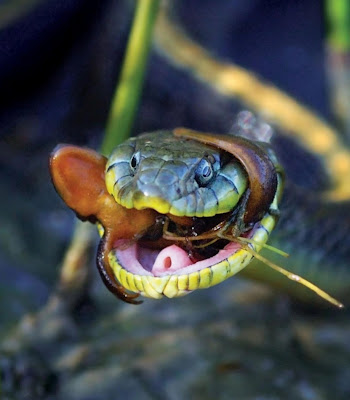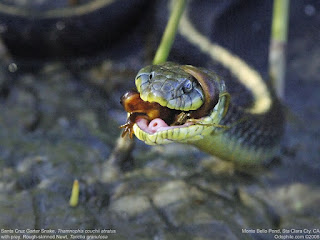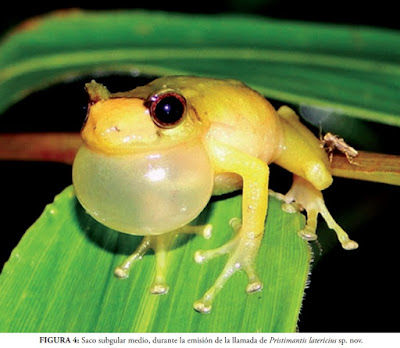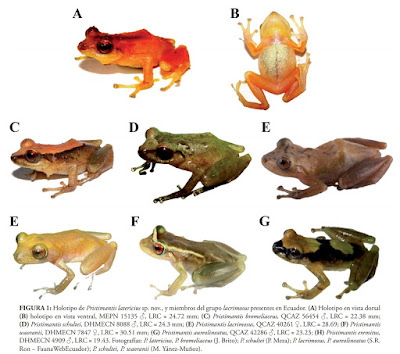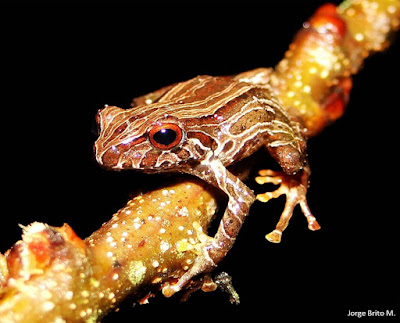[Most Recent Entries] [Calendar View]
Saturday, June 11th, 2016
| Time | Event | ||||
| 7:04a | [Herpetology / Evolution • 2016] Historical Contingency in a Multigene Family Facilitates Adaptive Evolution of Toxin Resistance
Highlights • Toxin resistance in sensory neurons evolved in reptiles before the origin of snakes • Resistant motor neurons evolved four times in snakes that eat amphibians • Coevolutionary arms races with toxic prey were facilitated by resistant nerves Summary Novel adaptations must originate and function within an already established genome. As a result, the ability of a species to adapt to new environmental challenges is predicted to be highly contingent on the evolutionary history of its lineage. Despite a growing appreciation of the importance of historical contingency in the adaptive evolution of single proteins, we know surprisingly little about its role in shaping complex adaptations that require evolutionary change in multiple genes. One such adaptation, extreme resistance to tetrodotoxin (TTX), has arisen in several species of snakes through coevolutionary arms races with toxic amphibian prey, which select for TTX-resistant voltage-gated sodium channels (Nav). Here, we show that the relatively recent origins of extreme toxin resistance, which involve the skeletal muscle channel Nav1.4, were facilitated by ancient evolutionary changes in two other members of the same gene family. A substitution conferring TTX resistance to Nav1.7, a channel found in small peripheral neurons, arose in lizards ∼170 million years ago (mya) and was present in the common ancestor of all snakes. A second channel found in larger myelinated neurons, Nav1.6, subsequently evolved resistance in four different snake lineages beginning ∼38 mya. Extreme TTX resistance has evolved at least five times within the past 12 million years via changes in Nav1.4, but only within lineages that previously evolved resistant Nav1.6 and Nav1.7. Our results show that adaptive protein evolution may be contingent upon enabling substitutions elsewhere in the genome, in this case, in paralogs of the same gene family.
Joel W. McGlothlin, Megan E. Kobiela, Chris R. Feldman, Todd A. Castoe, Shana L. Geffeney, Charles T. Hanifin, Gabriela Toledo, Freek J. Vonk, Michael K. Richardson, Edmund D. Brodie Jr., Michael E. Pfrender, Edmund D. Brodie III. 2016. Historical Contingency in a Multigene Family Facilitates Adaptive Evolution of Toxin Resistance. Current Biology. In Press. DOI: 10.1016/j.cub.2016.04.056 How an evolutionary arms race with snakes turned newts super toxic http://wpo.st/ASoe1 Snakes and newts have been locked in an evolutionary arms race since before they even existed. http://www.theatlantic.com/science/archi | ||||
| 12:17p | [Herpetology • 2014] Pristimantis latericius • A New Species of the Pristimantis lacrimosus Group (Amphibia: Craugastoridae) from Sangay National Park, Ecuador
ABSTRACT We describe a new species of terrestrial frog of the genus Pristimantis of medium-size (the SVL of males from 22.18 to 25.13 mm) found in the cloud forests of the eastern foothills of the Sangay National Park, located in the mid-eastern region of Ecuador at an elevation of 2750 meters. We assign the new species Pristimantis latericius sp. nov., to the Pristimantis lacrimosus group, differentiating it from the rest of the members of this group for having prominent tubercles on the upper eyelid and red-orange coloration on its dorsum. Calls are short, one-note, with two harmonic bands. In the last few years in the Sangay National Park, important faunal developments have been made. However further studies are necessary to help document the ecology and natural history of the amphibians, as they will help to understand ecological processes. The discovery of this and other new species in this region demonstrates its biological importance, validating the development of conservation plans in this important World Heritage Site. Key-words: New species; Parque Nacional Sangay; Pristimantis lacrimosus group; Pristimantis latericius sp. nov.; calls. RESULTADOS Pristimantis latericius sp. nov. (Figs. 1A-B; 2-4) Holotipo: Un macho adulto (MEPN 15135, numero de campo JBM 445), colectado en Tinguichaca, Parque Nacional Sangay, parroquia Zuñac, cantón Morona, provincia de Morona Santiago, República del Ecuador, el 22 de julio del 2012, por Jorge Brito M. Paratopotipos: Cinco machos adultos: (MEPN 14427-30), colectados el 28 de noviembre del 2011 y (MEPN 14425) colectado el 29 de febrero del 2012, todos recolectados en la localidad tipo, por Jorge Brito M. Etimología: El epíteto es un adjetivo del término griego latericius que significa ladrillo, el mismo que hace referencia a la coloración del dorso muy parecido a un ladrillo, el cual difiere del resto de especies del grupo Pristimantis lacrimosus presentes en Ecuador. Nombre propuesto en español: Cutín anaranjado de Tinguichaca. Proposed English names: Orange robber frog of Tinguichaca. Diego Batallas R. and Jorge Brito M. 2014. Nueva especie de rana del género Pristimantis del grupo lacrimosus (Amphibia: Craugastoridae) del Parque Nacional Sangay, Ecuador. Pap. Avulsos Zool. (São Paulo). 54(5); DOI: 10.1590/0031-1049.2014.54.05 Diego Batallas R. and Jorge Brito M. 2014. A New Species of the Pristimantis lacrimosus Group (Amphibia: Craugastoridae) from Sangay National Park, Ecuador. Pap. Avulsos Zool. (São Paulo). 54(5); DOI: 10.1590/0031-1049.2014.54.05 RESUMEN: Describimos una nueva especie de rana terrestre del genero Pristimantis de tamaño mediano (LRC en machos desde 22.18 a 25.13 mm) descubierta en los bosques nublados de las estribaciones orientales del Parque Nacional Sangay, al centro oriente de Ecuador, a elevaciones de 2750 m. Asignamos a Pristimantis latericius sp. nov., al grupo Pristimantis lacrimosus, el cual se diferencia del resto de miembros de este grupo por presentar tubérculos prominentes en el parpado superior y una coloración rojo anaranjado en el dorso. Las llamadas son cortas, conformadas por una sola nota y dos bandas armónicas. Importantes levantamientos de información faunística se han venido generando en los últimos años en el Parque Nacional Sangay, sin embargo es necesario incrementar estudios que ayuden a documentar la ecología e historia natural de los anfibios, ya que sin lugar a dudas ayudaran a comprender procesos ecológicos. El descubrimiento de esta y otras nuevas especies en este sector, demuestra su importancia biológica confortando al desarrollo de planes de conservación en este importante Patrimonio Natural de la Humanidad. Palabras-clave: Nueva especie; Parque Nacional Sangay; Grupo Pristimantis lacrimosus; Pristimantis latericius sp. nov.; llamadas. | ||||
| 12:24p | [Herpetology • 2016] Pristimantis tinguichaca • A New Species of Pristimantis (Amphibia: Strabomantidae) from the Cloud Forest of Sangay National Park, Ecuador
Abstract We describe Pristimantis tinguichaca sp. nov., a member of the Pristimantis unistrigatus species group, from the cloud forests of Sangay National Park located on the eastern slopes of the Andes in southeastern Ecuador. The new species was collected in cloud forests and cattle pastures at 2,750–2,830 m elevation. It differs from other members of the P. unistrigatus group by the presence of small conical tubercles on the upper eyelids and heels, as well as by its reddish-colored iris. It is further distinguished by its small conical ulnar and tarsal tubercles. A single sharp metallic note composed of a modulated frequency characterizes the call. Stomach content analysis revealed a diet composed principally of beetles (51.7%). Jorge Brito M., Reed Ojala-Barbour, Diego Batallas R. and Ana Almendáriz C.. 2016. A New Species of Pristimantis (Amphibia: Strabomantidae) from the Cloud Forest of Sangay National Park, Ecuador. Journal of Herpetology. 50(2):327-336. DOI: 10.1670/13-103 Resumen: Describimos a Pristimantis tinguichaca sp. nov. del grupo Pristimantis unistrigatus, de los bosques nublados del Parque Nacional Sangay de las estribaciones orientales de los Andes en el sureste de Ecuador, a elevaciones de 2,750–2,830 m. Difiere de otros miembros del grupo unistrigatus por la presencia de tubérculos cónicos pequeños en el párpado y talón, tubérculos ulnares y tarsales cónicos pequeños, e iris rojizo. El canto se caracteriza por un sonido metálico, grave; presenta llamados de frecuencia modulada, los mismos que están compuestos de una sola nota. El análisis de los contenidos estomacales reveló una dieta basada principalmente en coleópteros (51.7%). |
| << Previous Day |
2016/06/11 [Calendar] |
Next Day >> |
